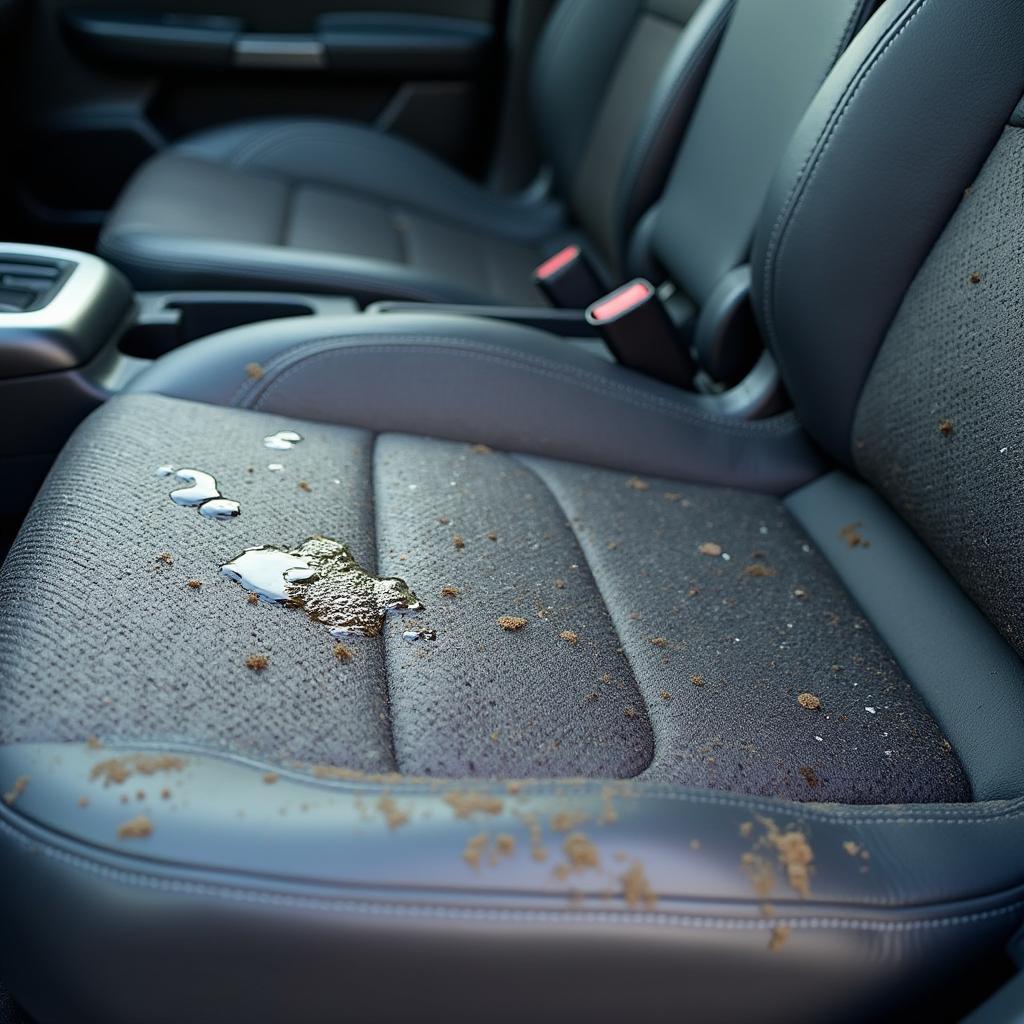Water damage to your car seats can be a real pain, leading to unpleasant odors, mold growth, and even material deterioration. Whether it’s from a spilled drink, a leaky sunroof, or leaving your window open during a downpour, knowing how to repair water damaged car seats can save you from costly replacements and keep your car’s interior looking its best.
This comprehensive guide will walk you through the steps to effectively address water-damaged car seats, from initial assessment to complete restoration.
Assessing the Damage: What You Need to Know
Before you begin the repair process, it’s crucial to determine the extent of the water damage. This will help you choose the right cleaning methods and materials.
- Identify the source of the water: Was it clean rainwater or something else like a sugary drink? Different liquids require different cleaning approaches.
- Assess the severity: Is the damage limited to a small area or has it spread to the entire seat? Deeply soaked seats might need professional attention.
- Check for mold: Look for any signs of mold or mildew, especially in hidden areas. Mold requires special cleaning agents to prevent its spread.
Drying is Key: Removing Excess Moisture
The first and most crucial step in repairing water-damaged car seats is to thoroughly dry the affected area.
- Remove excess water: Use a shop vacuum or towels to soak up as much water as possible.
- Promote air circulation: Roll down the windows and open the car doors to allow for proper ventilation.
- Use a dehumidifier: If the damage is extensive, consider using a dehumidifier to speed up the drying process.
- Avoid direct sunlight: While it might seem tempting, direct sunlight can cause the seat material to fade or crack.
Failing to dry the seats completely can lead to lingering odors and mold growth, making the problem much worse in the long run.
Cleaning: Tackling Stains and Odors
Once the car seats are completely dry, it’s time to address any remaining stains and odors.
For fabric seats:
- Vacuum thoroughly: Use a vacuum cleaner with upholstery attachments to remove loose dirt and debris.
- Apply an upholstery cleaner: Choose a cleaner specifically designed for car upholstery and follow the product instructions carefully.
- Scrub gently: Use a soft-bristled brush to work the cleaner into the fabric.
- Rinse and dry: Rinse the cleaner thoroughly with clean water and blot the area dry with a clean towel.
- Deodorize: Sprinkle baking soda on the affected area, let it sit overnight, and vacuum it up the next day to neutralize lingering odors.
For leather seats:
- Wipe with a mild soap solution: Mix a small amount of mild soap with warm water and gently wipe down the affected area.
- Avoid harsh cleaners: Harsh chemicals can damage leather, so stick to cleaners specifically designed for leather car seats.
- Condition the leather: After cleaning, apply a leather conditioner to restore its moisture and prevent cracking.
Stubborn Stains and Professional Help
Some stains, especially those caused by sugary drinks or colored liquids, can be stubborn to remove. If home remedies aren’t effective, it’s best to seek professional help.
“When dealing with water damage, time is of the essence,” says John Miller, a veteran car detailer with over 20 years of experience. “The sooner you address the issue, the better your chances of preventing permanent damage and minimizing repair costs.”
Professional detailers have the experience and specialized tools to tackle even the most stubborn stains and odors. They can also assess the damage accurately and recommend further repairs if necessary.
Repairing or Replacing Damaged Components
In some cases, water damage might extend beyond the surface of the car seat. You might need to repair or replace components like:
- Seat padding: If the padding is heavily soaked or damaged, it needs to be replaced to prevent mold and mildew growth.
- Seat covers: Torn or heavily stained seat covers might need to be repaired or replaced to restore the car’s interior aesthetics.
- Seat heating elements: If your car has heated seats, ensure that the heating elements are functioning correctly after water exposure.
how to repair a car seat upholstery provides a detailed guide on handling upholstery issues, including water damage.
Preventing Future Water Damage
Prevention is always better than cure. Take these steps to prevent water damage to your car seats in the future:
- Check for leaks: Regularly inspect your car for any signs of water leaks, such as wet carpets or condensation on windows.
- Use seat covers: Consider using waterproof seat covers, especially if you frequently transport children or pets.
- Be mindful of spills: Clean up any spills immediately to prevent them from soaking into the seats.
- Park in shaded areas: Parking your car in the shade can help prevent the interior from getting too hot and humid, reducing the risk of condensation and mold growth.
By following these preventative measures, you can protect your car seats and keep your car’s interior looking and smelling fresh for years to come.
Conclusion: Keeping Your Car Seats in Top Condition
Water damage to car seats is a common problem but can be effectively addressed with prompt action and proper care. By following the steps outlined in this guide, you can restore your car seats to their former glory and prevent further damage. Remember, when in doubt, it’s always best to consult with a professional car detailer or upholstery repair specialist to ensure the best possible outcome.


